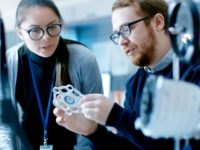Podcast: Additive Manufacturing Inspection

Michelle Bangert, managing editor of Quality, talks with Greg Weaver of Weaver NDT about additive manufacturing inspection.
Michelle: So I know you've written for us about this in the past and worked in this field for a long time. But are there any trends you've seen lately with additive inspections?
Greg: I think the biggest trends that are really active right now is monitoring the build itself and trying to correct any issues that are found at that part to alleviate the inspections once the parts are made.
Michelle: That makes sense. It's kind of the main ideas of quality, I guess, don't inspect right at the end when it's too late to improve things. So it sounds good.
Greg: And I think the criticality of the part depends on what you can do with those monitorings and how often you have to actually inspect parts in addition to that.
Michelle: So for aircraft it would be different versus you know something kind of smaller and less critical?
Greg: Absolutely.
Michelle: Good. So for quality professionals who are kind of looking to improve their skills related to this type of inspection, is there anything you would suggest they do or areas they should turn to for more information?
Greg: Well, I think on the monitoring side, a lot of that is being protected by, you know, the machine manufacturers and the OEMs that are controlling that. But I think just that in general, right, understanding which methods are getting looked at, which methods are being implemented in that monitoring process is an area where people could focus, you know, at least do research and understand what's happening there and what they're finding.
Michelle: Sounds good. And so with additive, have you seen any areas where it is particularly growing or there's kind of been more interest in it lately?
Greg: I believe that the medical devices, the implants, are coming a long way. There is a lot of structured implants that are being approved by the FDA to do, say like a disc implant for a spine and things like that that are seen to be making ground for approvals and getting implemented.
Michelle: Definitely very important field there, kind of going into the body, so that makes sense. Are there any misconceptions you've seen about additive inspection where people kind of don't understand how it works or what's needed?
Greg: I think the biggest misconception is people don't understand that there's different ways to produce additive manufacturing, right? A lot of people think of it as just a powder bed fusion, and then there's other people that think it's more just a direct welding technique. It's direct energy deposition. And there's five or six actual ways to manufacture that are different in and unique in themselves. And all of those are encompassed in additive manufacturing. So I think there is a misconception of what that is. And I think a lot of people just assume it's like this powder bed fusion that most people are doing and putting out there.
Listen to the Full Podcast Here:
Looking for a reprint of this article?
From high-res PDFs to custom plaques, order your copy today!





